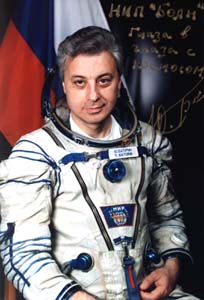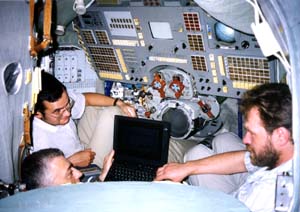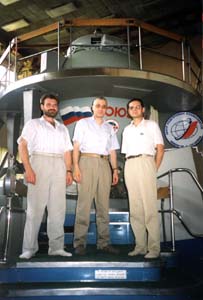FUNCTIONAL CONDITION OF THE COSMONAUT'S VISUAL SYSTEM IN OUTER SPACE
(The Article presented on the INABIS'98 Congress.)
Leonid I. Nesteruk, PhD, Helmholtz Institute of Eye Diseases, Moscow, Russia.
Alexey B. Prokofiev, PhD, MD, Boyan Research Inc., Moscow, Russia.
Yuri M. Baturin, PhD, PhD, Cosmonaut's Training Center, Zviozdny, Russia.
![]()
HISTORY
During the "Expedition Number 26", August 13-25, 1998, The Cosmonaut - Researcher Yury Baturin had completed the Special Program of investigation, which 1st time had the primary interest in the complex evaluation of the visual system’s functional condition.
 |
 |
 |
| Cosmonaut - Researcher Yury Baturin | Pre-started classes and preparations | Authors of the article from the left: L.Nesteruk, Y.Baturin, A.Prokofiev |
Actually, the numerous studies of the different visual functions were done in Outer Space as well as during the modeling of the flight conditions. This way the primary attention was paid to the study of the following parameters of the visual system: visual acuity, chromatic and contrast sensitivity, accommodation and convergence (Y.P. Petrov, 1969, O.O. Riumin, 1980; A.P. Ginsburg, J. Vahderploeg., 1985; L.P. Zverev., I.G. Ovechkin., O.O. Riumin, 1996). It was found the visual acuity being highly stable and does not change during the flight (E.V. Khrunov, L.S. Khachaturiantz, V.A. Popov, 1974). The same data were obtained in the experimental researches in the modeling of the haemodynamic shifts typical for the weightlessness (J.H Kilp., Heublen , 1984).
At the same time, some investigations demonstrated the negative dynamics of the parameters of the accommodation and convergence, as well as the asthenopic symptoms in cosmonauts even at the beginning of the flight (Y.P. Petrov, 1969). Those symptoms were not progressed and some investigators did not obtain them at all and followed the conclusion on the stability of the accommodation during the flight (O.O. Riumin, 1980).Also, the studies of the color vision and color discrimination in cosmonauts (A.L. Kitaev-Smik, 1969; L.P. Zverev., I.G. Ovechkin., O.O. Riumin, 1996) showed the absence of the valuable variations of the mentioned parameters under the given condition. The results of the contrast sensitivity examinations in the spaceship’s crew during the flight demonstrated the 14-16 % decrement (A.P. Ginsburg, J. Vahderploeg, 1985) which believed by the authors can’t be the reason of the reduction in functional condition of the cosmonaut.
So, the analysis of the sources in the area from one hand let us draw the conclusion that the variations of the main visual functions of the cosmonaut during the flight are insignificant and are practically in the range of the physiological norm. From the other hand, the range of the investigations in outer space was obviously insufficient and was limited by the restricted set of the traditional methods.
PURPOSES
To develop the PC-based System of Connected Methods of the functional condition investigations on the different levels of the visual system’s (VS) organisation and to study variations of the cosmonaut’s VS parameters in the space vehicle "Soyuz" and on the board of the orbital piloted complex "Mir".
METHODS
The special PC-notebook program named "Ocular-complex" realizing the extended system of psychophysical methods of VS investigation was used. The functional core of the program was constituted by the “Ocular” program, Color Campimetry methods (Nesteruk L.I., 1992; Nesteruk L.I., 1994; Nesteruk L.I, Shamshinova A.M., Endrichovsky S.E., 1995; Nesteruk L.I., 1997; Shamshinova A.M., Endrichovsky S.N., Nesteruk L.I., Yacovlev A.A., 1997).
The following visual tests were realized there:
The Cosmonaut - Researcher Y. Baturin had performed visual tests every day, except of the 1st day on the Station "Mir". Pre- and after- expedition studies also were done including one right after the landing and during 1 week of adaptation.
The processing of the data of the present investigation was performed by the PC-package “Statistica”.
RESULTS
|
It was shown for acuity of vision being stable during the experiment (before, during and after the flight) except of the 9th day of the flight, when only colored combinations (green on purple) demonstrated the negative dynamics for 50%, 10% and 10% in 3 examinations during the time interval of 8 hours. The statistically significant achromatic and colored LSTs (“Ocular”) both was found to be increased during the flight in comparison with ones detected before and after the flight and was shown to have the different gradient in the center and paracenter of the visual field (Fig.4, 5, 6). The LST’s maximum during the flight (minimum sensitivity) was detected in 4-5 and 12-13 days. The LST’s minimum (maximum sensitivity) was detected in 8-9 days of the flight, after which the LST’s dynamics was negative till the end of the flight. After 1 week of adaptation (4, 6 and 8 days) the LST parameters reached the pre- flight level. That was not found the statistically significant difference between LST parameters before and after the flight. |
Rhythm's acquisition and reproduction dynamics (“Ocular-Rhythmic”) after the complicated visual stimulation (Fig.7, 8, 9) demonstrated the maximum time’s precision of reproduction (Mean Value) on the the 9th - 10th day of the flight, which has the statistically significant difference in comparison with the values before and after flight. At the same time the variability of reproduction (Standard Deviation) was also maximal, and the stability (inverse to the Gradient) of those parameters during the flight was minimal. It should be noted here that the Gradient was negative except of 2-3th days of the flight (in the Spaceship), 15th day (before landing) and at the end of the 1st week of adaptation after the flight. |
|
|
"Simple" cognitive functions investigation (“Ocular-Gnostic”) after the complicated visual stimulation (Fig. 10) was found to have the maximal value of the coefficient in the flight (9th - 10th day, Station “Mir”), not in the earth based ones. Interestingly, the statistically significant difference of the coefficient was found only between ones before the flight and during the presence of the cosmonaut on the Station. No significant difference was found not only before and after the flight, but in the flight and after the flight too. |
The results of the last three tests demonstrated the optimal values of the parameters about the 9th day of the flight.
DISCUSSION
That was pointed out the data of the previous investigations on the visual functions in the real and modeled cosmic flight had demonstrated the absence of the principal shifts in the VS's functional condition of a cosmonaut. At the same time it is believed to be obvious, that the factors of the cosmic flight should make a significant influence on the VS. Those factors are known to cause the valuable changes in the following physiological (and connected psychological) processes: the start of the pathogenetic mechanisms in the general blood support system connected with haemodynamical effects of the weightlessness and hypodynamia as well as with the variations of the functional condition of the central and peripheral nervous system. Even the shape of the eyeball is changing when the weightlessness (tended to be more spherical).
The subjective reports of the cosmonauts as well as one of the cosmonaut - researcher Y. Baturin show sometimes the dramatic changes in vision.
The reason of the drawn contradictories might be seen in the following:
The results of the present investigation show that an alternative approach to the solution of the given problem can be found using the "Ocular-complex" system, realizing psychophysical methods of investigation correspondent to the different levels of the VS’s organization (Nesteruk L.I., 1992; Nesteruk L.I., 1994; Nesteruk L.I, Shamshinova A.M., Endrichovsky S.E., 1995; Nesteruk L.I., 1997).
The interesting fact demonstrated with the "Ocular-complex" is the reliable difference in the functional condition of the VS before, during and after the space flight. This difference could be characterized as a negative dynamics during the space flight, which has a distinctive character showed by all the 5 applied tests, correspondent to the various levels of the VS. The improvement of major parameters about the 9th day of the flight is correspondence with the data obtained on the cardio-vascular, respiratory and other functional systems (E.V. Khrunov, L.S. Khachaturiantz, V.A. Popov, 1974; C.L. Fisher, J.Degianni, 1982). The parameters of the tests during the 1st week of the after flight adaptation was tended to rich the ones obtained before the flight, which is also supported with investigations of other functional systems.
The analysis of the results shows the evidence on the high stability of the visual acuity, the integrated parameter of the VS, to the influence of the damaging factors in the space flight. The study of the LSTs (Color Campimetry) in the central and paracentral parts of the VF on the achromatic and colored background let us reveal the tendency to the reliable decrement of the light and color sensitivity during the flight in comparison with the earth - based ones. It should be noted the presence of the 2 peaks of LSTs (decrements of the sensitivity) in the 4-5 and the 12-13 days of the flight. The best sensitivity (lowest LSTs) during the flight was registered in 8-9 days, which however were lower than one before the flight.
The remarkable fact of the improving of the coefficient of the “Simple” cognitive functions (“Ocular-Gnostic”) as well as it’s mounting to the maximum value during the flight, in comparison with the earth - obtained one, might appoint on the optimal level of the VS’s adaptation and on the best VS’s central part performance.
Analyzing the dynamics of the mentioned parameters the assumption could be drawn here on the some rhythmical, oscillatory character of the VS functioning under the space flight conditions, manifested in the periodical variations in the functional condition of the neuro- receptor and cortical levels of the VS.
Unfortunately, the insufficiency of the experimental material, restricted by the time of the flight as well as the number of investigations, does not let us to follow the mentioned tendency in time, and also to explain it from the point of the haemodynamical shifts happened in the organism under the weightlessness condition.
CONCLUSIONS
ASKNOWLEGEMENT
The first two authors would like to outline that the present investigation was found to rich the auditorium because of the enthusiasm and the intelligence of the Cosmonaut - Researcher Y. Baturin, who had continued to perform visual test even in the extremal situations, when nobody believed it could be done.
REFERENCES
Culver J.F.
Aerospace ophtalmology // Aerospace medicine. Baltimor: 514-533. 1971.
Fisher C.L., Degianni J.
Evaluation of crew healh // STAR. Vol.20., 6: 815. 1982.
Ginsburg A.P., Vahderploeg J.
The effect on weghtlessness on contrast sensibiliti of Space Shuttle crew members // ASEM.
Vol. 56., 5: 492-498. 1985.
Kilp J.H., Heublen C.
Effects of 7 days antiorthostatic bedrest (6 HDT) on ophtalmological parametrs // ASEM.
Vol. 56., 5: 451. 1984.
Weale R.A.
Aging and vision // Vision Res. Vol 2: 621-640. 1986.
Nesteruk L.I.
Computer Analysis of Retinal Functions. In: Abstract book: Conference "New Visions,
New Ventures", Oakland, USA: 102. 1992.
Nesteruk L.I.
New Psychophysical Methods of Eye Diseases Diagnostics with IBM PC. In: Abstract book: 6th
European Regional Conference of Rehabilitation International, Budapest: 33-34. 1994.
Nesteruk L.I, Malova J.V.
Study of Time Disturbances in Normal and Patients With Brain Disorders. In: Abstract book:
6th European Regional Conference of Rehabilitation International, Budapest: 38. 1994.
Nesteruk L.I, Shamshinova AM, Endrichovsky SE.
Color Campimetry In The Diagnostics Of The Light And Color Sensitivity. In: Abstract book:
X Cogress of European Society of Ophthalmology, Milano, (SOE 95): 296. 1995.
Nesteruk L.I.
Color Campimetry: The Three-Stages-Studies Concept In Early Glaucoma Diagnostics.//
Proceedings of the XI Cogress of European Society of Ophthalmology, Budapest, (SOE 97):
296. 1997.
Shamshinova A.M., Endrichovsky S.N., Nesteruk L.I. and Yacovlev
A.A.
New Method for Investigation of Colour Sensitivity. in John Dalton's Colour Vision Legacy,
ed.by Ch.Dickinson,I.Murray and D.Carden, Taylor&Francis, UK: 317-324. 1997.
Beregovoi G.T., Grigorenko V.N., Bogdashevski R.B.
The Cosmic Academy. //Moscow. Mashinostroenie: 1-152. (in Rus.) 1987.
Kitaev-Smik A.L.
The Study of Achromatic and Chromatic Sensitivity of Vision in the Sort Influence of the
Weightlessness. The Problems of the Physiological Optics, 15: 130-133 (in Rus.) 1969.
Leonov A.A., Lebedev V.I.
Psychological Aspects of the Cosmonauts Activity. //Moscow. Nauka: 1-248. (in Rus.) 1971.
Petrov Y.P.
The Influence of the Factors of the Space Flight on the Visual Functions. Physiology of
Vision in Norm and Extremal Conditions, AS USSR: 124-127. (in Rus.) 1969.
Riumin O.O.
The Influence of the Refractive Abilities of the Visual Analizator on the Reliability of
the Operators Functioning in the System of Visual Observation. Methodical and Technical
Aspects of the Experimental Psychophysiology. //Moscow. Nauka: 24-28. (in Rus.) 1980.
Zverev L.P., Ovechkin I.G., Riumin O.O.
Color Measurements in Outer Space. //Moscow. Mashinostroenie: 1-176. (in Rus.) 1996.
Khrunov E.V., Khachaturiantz L.S., Popov V.A.
Human - Operator in the Space Flight. //Moscow. Mashinostroenie: 1-339. (in Rus.) 1974.
Ocular © Copyright 1995-1998. BOYAN Research inc. All
Rights Reserved.
Designed by Pitenin A.J.